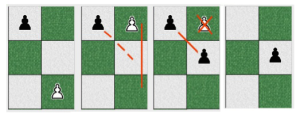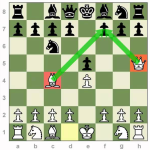 En passant is a special pawn capture move that can only occur immediately after a pawn moves two ranks forward from its starting position, and an enemy pawn could have captured it had the pawn moved only one square forward. The opponent captures the just-moved pawn “as it passes” through the first square. The resulting position is the same as if the pawn had moved only one square forward and the enemy pawn had captured it normally. The en passant capture must be made at the very next turn, or the right to do so is lost. It is the only occasion in chess in which a piece is captured but is not replaced on its square by the capturing piece.
En passant is a special pawn capture move that can only occur immediately after a pawn moves two ranks forward from its starting position, and an enemy pawn could have captured it had the pawn moved only one square forward. The opponent captures the just-moved pawn “as it passes” through the first square. The resulting position is the same as if the pawn had moved only one square forward and the enemy pawn had captured it normally. The en passant capture must be made at the very next turn, or the right to do so is lost. It is the only occasion in chess in which a piece is captured but is not replaced on its square by the capturing piece.
The en passant capture rule was added in the 15th century when the rule that gave pawns an initial double-step move was introduced. It prevents a pawn from using the two-square advance to pass an adjacent enemy pawn without the risk of being captured. Allowing the en passant capture, together with the introduction of the two-square first move for pawns, was one of the last major rule changes in European chess, and occurred between 1200 and 1600.
In today’s chess club meeting, we showed a Chesskid.com video that explains the en passant rule. You can view that video here:













You must be logged in to post a comment.